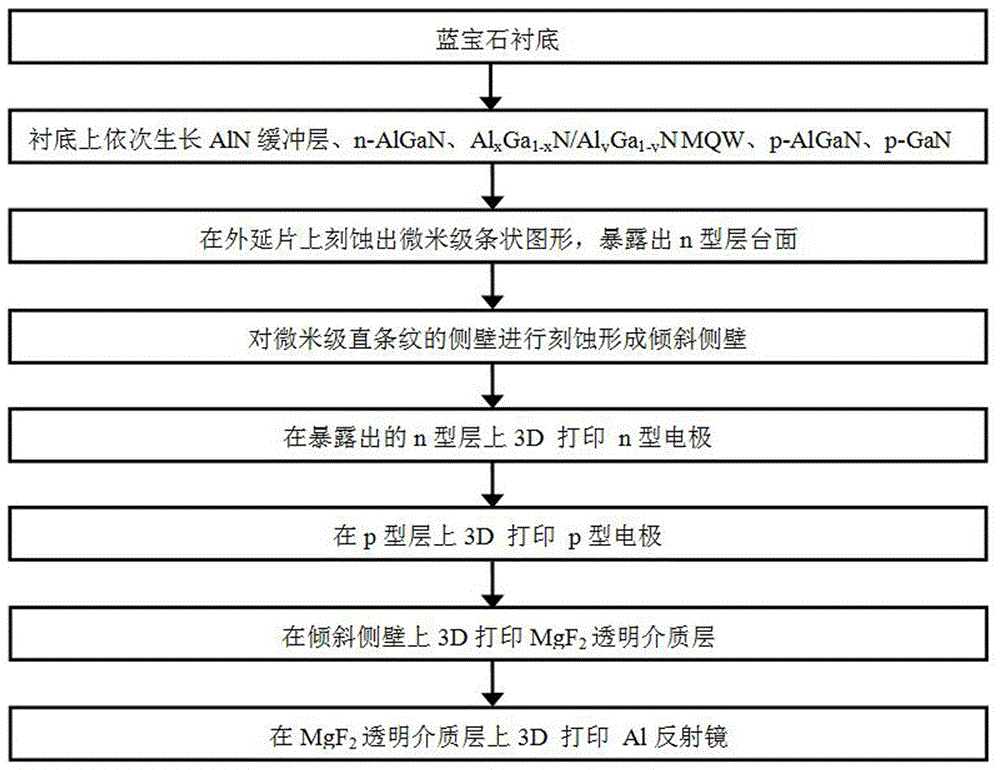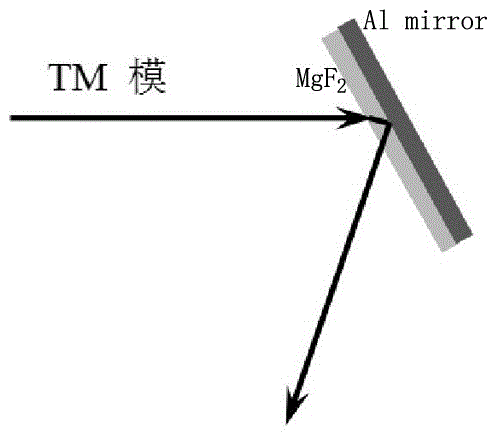Preparation of sidewall reflector DUV LED based on3D printing
A 3D printing and mirror technology, applied in electrical components, circuits, semiconductor devices, etc., can solve problems such as limited effect, and achieve the effect of improving production efficiency, improving light output efficiency, and simple production process
- Summary
- Abstract
- Description
- Claims
- Application Information
AI Technical Summary
Problems solved by technology
Method used
Image
Examples
Embodiment 1
[0027] Sapphire is provided as a substrate.
[0028] Step 1: sequentially grow AlN buffer layer, n-AlGaN layer, multi-period Al x Ga 1-x N / Al y Ga 1-y Epitaxial wafer of N active layer (where x<y), p-AlGaN layer and p-GaN contact layer.
[0029] Step 2: Uniformly and parallelly etch micron-scale straight stripes on the epitaxial wafer, the etching depth reaches the n-AlGaN layer, and the distribution density of straight stripes is 5 pieces / mm 2 , and etch the sidewalls formed by the straight stripes to form inclined sidewalls with an inclination angle of 80°.
[0030] Step 3: Write the motion path program of each 3D printing head, put the cleaned epitaxial wafer as a substrate into the 3D printer; use a single or array 3D N-type electrode printing head to print n-type on the exposed n-AlGaN layer electrode.
[0031] Use a single or array 3D P-type electrode print head to print p-type electrodes on the p-GaN contact layer between the straight stripes, the p-type electrode...
Embodiment 2
[0035] Sapphire is provided as a substrate.
[0036] Step 1: sequentially grow AlN buffer layer, n-AlGaN layer, multi-period Al x Ga 1-x N / Al y Ga 1-y Epitaxial wafer of N active layer (where x
[0037] Step 2: Uniformly and parallelly etch micron-scale straight stripes on the epitaxial wafer, the etching depth reaches the n-AlGaN layer, and the distribution density of straight stripes is 50 pieces / mm 2 , and etch the sidewalls formed by the straight stripes to form inclined sidewalls with an inclination angle of 20°.
[0038] Step 3: Write the motion path program of each 3D printing head, put the cleaned epitaxial wafer as a substrate into the 3D printer; use a single or array 3D N-type electrode printing head to print n-type on the exposed n-AlGaN layer electrode.
[0039] Use a single or array 3D P-type electrode print head to print p-type electrodes on the p-GaN contact layer between the straight stripes, the p-type electrod...
Embodiment 3
[0043] Sapphire is provided as a substrate.
[0044] Step 1: sequentially grow AlN buffer layer, n-AlGaN layer, multi-period Al x Ga 1-x N / Al y Ga 1-y Epitaxial wafer of N active layer (where x
[0045] Step 2: Uniformly and parallelly etch micron-scale straight stripes on the epitaxial wafer, the etching depth reaches the n-AlGaN layer, and the distribution density of straight stripes is 30 pieces / mm 2 , and etch the sidewalls formed by the straight stripes to form inclined sidewalls with an inclination angle of 50°.
[0046] Step 3: Write the motion path program of each 3D printing head, put the cleaned epitaxial wafer as a substrate into the 3D printer; use a single or array 3D N-type electrode printing head to print n-type on the exposed n-AlGaN layer electrode.
[0047] Use a single or array 3D P-type electrode print head to print p-type electrodes on the p-GaN contact layer between the straight stripes, the p-type electrod...
PUM
 Login to View More
Login to View More Abstract
Description
Claims
Application Information
 Login to View More
Login to View More - R&D
- Intellectual Property
- Life Sciences
- Materials
- Tech Scout
- Unparalleled Data Quality
- Higher Quality Content
- 60% Fewer Hallucinations
Browse by: Latest US Patents, China's latest patents, Technical Efficacy Thesaurus, Application Domain, Technology Topic, Popular Technical Reports.
© 2025 PatSnap. All rights reserved.Legal|Privacy policy|Modern Slavery Act Transparency Statement|Sitemap|About US| Contact US: help@patsnap.com



